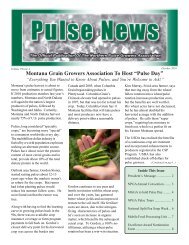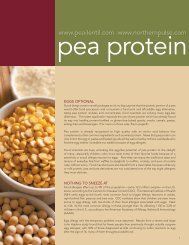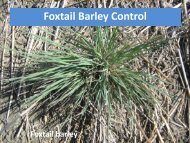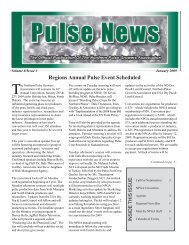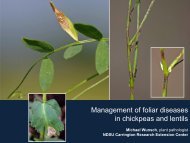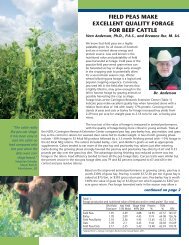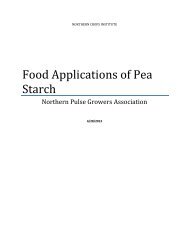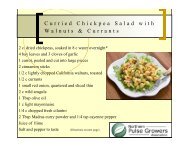Feed Peas in diets for shrimp tilapia and milkfish - Northern Pulse ...
Feed Peas in diets for shrimp tilapia and milkfish - Northern Pulse ...
Feed Peas in diets for shrimp tilapia and milkfish - Northern Pulse ...
You also want an ePaper? Increase the reach of your titles
YUMPU automatically turns print PDFs into web optimized ePapers that Google loves.
Digestibility Experiments. As <strong>in</strong>gredient <strong>in</strong> <strong>tilapia</strong> diet, feed pea has apparent dry matter digestibility(ADMD) of 69.3+1.8% <strong>and</strong> apparent prote<strong>in</strong> digestibility (APD) of 87.2±2.0%. The digestibility of some ofthe <strong>diets</strong> used <strong>in</strong> experiments 1 <strong>and</strong> 2 was also determ<strong>in</strong>ed <strong>in</strong> separate feed<strong>in</strong>g trials. The ADMD of the<strong>diets</strong> <strong>in</strong>creased as feed pea <strong>in</strong>clusion level <strong>in</strong>creased. The APD of the fishmeal-based <strong>diets</strong> or the plantbased<strong>diets</strong> were all high, exceed<strong>in</strong>g 90%.Overall, feed pea meal may substitute up to 50% of fish meal prote<strong>in</strong> (equivalent to 63.3% feed pea) <strong>and</strong>35% of the plant prote<strong>in</strong>s (41% feed pea) <strong>in</strong> the <strong>diets</strong> of Nile <strong>tilapia</strong> without any adverse effect on fishgrowth <strong>and</strong> survival.Study 3. Milkfish (Chanos chanos, Forsskal)The efficacy of feed pea meal as an alternative prote<strong>in</strong> source <strong>for</strong> <strong>milkfish</strong> was tested <strong>in</strong> a 12-week feed<strong>in</strong>gtrial. All test <strong>diets</strong> were made isonitrogenous (30% crude prote<strong>in</strong>) <strong>and</strong> isocaloric (15.7 kJ g –1 ). The controldiet conta<strong>in</strong>ed fish meal, soybean meal, meat <strong>and</strong> bone meal, <strong>and</strong> copra meal as prote<strong>in</strong> sources. <strong>Feed</strong>pea meal was substituted at 0, 5, 10, 15, 20, 25, <strong>and</strong> 30% of total prote<strong>in</strong>. A lead<strong>in</strong>g commercial <strong>milkfish</strong>feed was also tested as an additional control. The experimental <strong>diets</strong> were fed to triplicate groups of<strong>milkfish</strong> f<strong>in</strong>gerl<strong>in</strong>gs (mean <strong>in</strong>itial weight =0.42±0.01g) at 10% body weight /day.Results showed that % weight ga<strong>in</strong> (WG) of <strong>milkfish</strong> juveniles fed <strong>diets</strong> with 5% (WG= 833.1) <strong>and</strong> 10%(WG=835.3) feed pea <strong>in</strong>clusion did not significantly differ from that of the SEAFDEC control diet (0% feedpea <strong>in</strong>clusion; WG=834.8). However, % weight ga<strong>in</strong> obta<strong>in</strong>ed <strong>for</strong> <strong>milkfish</strong> juveniles fed with 15%(WG=691.0) <strong>and</strong> 20% (WG=680.0) feed pea <strong>in</strong>clusion <strong>in</strong> the diet were significantly higher than thecommercial <strong>milkfish</strong> feed <strong>for</strong>mulation (no feed pea <strong>in</strong>clusion, WG=581.4). Survival ranged from 70-90%.FCR was between 2.1 to 2.60 while PER ranged from 1.15 to 1.44.Dietary crude prote<strong>in</strong> digestibility values of the experimental <strong>diets</strong> were 84.8 to 89.2% suggest<strong>in</strong>g that feedpea prote<strong>in</strong> is well digested by <strong>milkfish</strong>.Over-all results <strong>in</strong>dicate that feed peas could be used as an alternate dietary prote<strong>in</strong> source <strong>for</strong> <strong>milkfish</strong>juveniles. Optimum level of <strong>in</strong>clusion without am<strong>in</strong>o acid supplementation is 10% of the dietary prote<strong>in</strong>(131g feed pea/kg dry diet). Dietary prote<strong>in</strong> <strong>in</strong>clusion levels up to 20% feed peas (260g/kg diet) are stillacceptable.General ConclusionsThese feed<strong>in</strong>g trials clearly demonstrate that whole feed pea can be <strong>in</strong>corporated as an alternative prote<strong>in</strong>source <strong>in</strong> <strong>diets</strong> <strong>for</strong> <strong>tilapia</strong>, <strong>milkfish</strong>, <strong>and</strong> <strong>shrimp</strong>. S<strong>in</strong>ce feed peas have a moderate prote<strong>in</strong> content (23-25%)compared to fish meal (65-70%), their <strong>in</strong>corporation <strong>in</strong> fish <strong>diets</strong> needs to be balanced with other prote<strong>in</strong><strong>in</strong>gredients, especially <strong>for</strong> fish that require high prote<strong>in</strong> levels <strong>in</strong> their diet. In this case, feed pea canthere<strong>for</strong>e be used as one of the <strong>in</strong>gredients that would collectively replace fish meal <strong>in</strong> practical <strong>diets</strong>.The replacement of other plant prote<strong>in</strong> sources with feed pea is possible as evidenced by the studiesconducted. <strong>Feed</strong> peas conta<strong>in</strong> high levels of lys<strong>in</strong>e, which could complement the am<strong>in</strong>o acids of other<strong>in</strong>gredient substitutes that are deficient <strong>in</strong> such am<strong>in</strong>o acids. The relatively low level of sulfur am<strong>in</strong>o acids(i.e., methion<strong>in</strong>e <strong>and</strong> cyst<strong>in</strong>e) <strong>in</strong> feed pea meal may limit the use of this plant prote<strong>in</strong> source depend<strong>in</strong>gupon the requirement of the species <strong>and</strong> the diet <strong>for</strong>mulation.The pea variety used <strong>in</strong> these studies conta<strong>in</strong>s low levels of anti-nutritional factors <strong>and</strong> is similar to mostfeed pea varieties now supplied <strong>in</strong> global markets. Thus, positive results were obta<strong>in</strong>ed <strong>for</strong> <strong>shrimp</strong> <strong>and</strong><strong>tilapia</strong>, even at high levels of <strong>in</strong>corporation <strong>in</strong> the <strong>diets</strong>. The relatively lower per<strong>for</strong>mance of <strong>milkfish</strong>compared to <strong>shrimp</strong> <strong>and</strong> <strong>tilapia</strong>, even with feed pea compris<strong>in</strong>g 15% of the diet, may be attributed to am<strong>in</strong>oacid deficiencies or possibly to effects from certa<strong>in</strong> anti-nutritional factors. However, it is notable that thegrowth response of <strong>milkfish</strong> fed the 15% feed pea diet was still better than from the commercial <strong>milkfish</strong>diet, which conta<strong>in</strong>ed no feed pea, so further study is needed.The availability of feed pea meal as an alternative prote<strong>in</strong> source <strong>for</strong> <strong>tilapia</strong>, <strong>milkfish</strong>, <strong>and</strong> <strong>shrimp</strong> may openavenues <strong>for</strong> commercial producers to reduce feed costs. <strong>Feed</strong> peas have a higher carbohydrate content(65-67%) compared to soybean meal (44-45%), which may provide a lower cost <strong>and</strong> more digestible energysource <strong>for</strong> the animals.2




